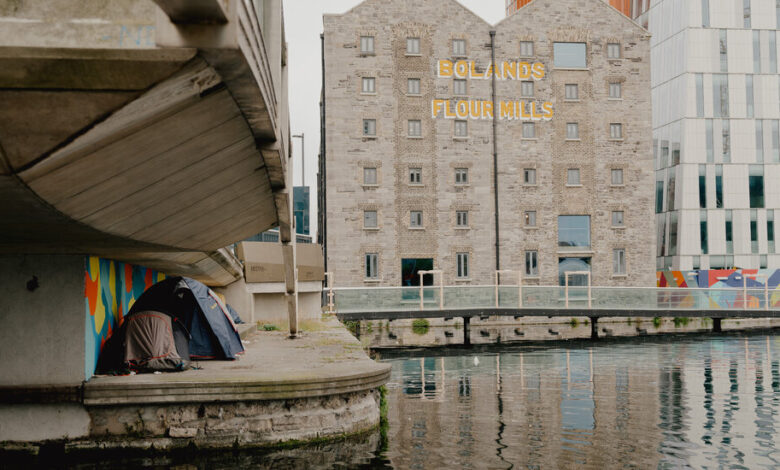Ireland’s Latest Fiscal Headache: What to Do With 10 Billion Euros

Fifteen years after a collapsed housing bubble forced Ireland to borrow tens of billions of dollars or risk going bust, the country is discovering that having too much money can also be a problem.
Swollen by rising corporate tax revenue, mainly from American tech and pharmaceutical corporations, the government is expecting to have a record budget surplus of 10 billion euros ($10.9 billion) this year. Next year, the windfall is projected to be even larger, reaching €16 billion.
For years, Ireland’s low corporate tax rate has lured multinational organizations to set up overseas subsidiaries here. Their tax payments have created a financial cushion for the government, while stirring the ire of other countries.
Although plans promoted by the United States and others to create a global corporate tax rate have slowly progressed — a change that could undermine Dublin’s position as a low-tax haven — the payments to Ireland have ballooned.
Which leaves Irish lawmakers in a quandary. As the government prepares its annual budget statement in October, it must settle the tricky question of what to do with this pot of money.
Chief among the options: save it for the future; pay off debts; invest in badly needed housing or some other infrastructure, like hospitals, schools and a subway system for Dublin; or give it away in tax cuts and support payments.
Yet for peculiarly Irish reasons, none of these apparent boons would be, in itself, an easy option.
“Whatever they do, it will leave some people feeling very grumpy,” said Cliff Taylor, a business columnist at The Irish Times. There is talk, he said, of putting the money aside in a sovereign wealth fund, to help support rising pension costs as the population ages.
“But if they do that,” he said, “other people will say that we urgently need to spend money today on things like housing and transport and health, and changing our energy system to cope with climate change.”
Looming over the debate are warnings that this annual windfall is unpredictable, and that the country must not become dependent on it. Ireland’s infrastructure, especially its housing, is by common agreement in dire condition. New construction, which produced a glut of homes during the Celtic Tiger housing boom of the late 1990s and early 2000s, collapsed when the bubble burst in 2008, and the government was forced to borrow $77 billion from international lenders to stay afloat.
Ireland, with one of the fastest growing populations in Europe, now has a severe shortage of homes and apartments. High rents have left many young people struggling to find a place to live. And the number of homeless people, including working families, has steadily climbed.
The lack of housing and other infrastructure is now becoming a serious obstacle to economic growth, according to the Irish Business and Employers Confederation, a lobbying group representing both domestic and multinational businesses.
“Companies can’t attract or retain the people they need,” said Fergal O’Brien, the group’s executive director of lobbying. “The economy is doing well right now, but our members are saying they are leaving so much potential on the table.”
One proposal that has won backing in public opinion polls and by the business confederation would be to set aside some or all of the surplus money for long-term spending projects, based on a national plan.
A recent Irish Times poll suggested that 40 percent of the public preferred that the extra money be spent on “public transport, housing, hospitals and schools,” while another 25 percent favored spending on public services like health and education. Only 9 percent selected tax cuts as their first choice. Five percent or less preferred paying down national debt or saving for future pensions costs.
But one obstacle to spending money on major projects, said Eoin Reeves, an economics professor at the University of Limerick, is that the Irish government has not been efficient at spending large sums of money on big investments.
In good times, he said, governments have spent money on big projects. “But then as soon as things get tough, they stop,” said Professor Reeves, an expert on public procurement. “Ideally, you’d earmark funds in advance to keep the spending up and to stimulate the economy when there’s a downturn, but we never get that right. We never think in terms of the long-term.”
Even by global standards, big infrastructure projects in Ireland tend to be completed late and far over budget. In 2015, a new 3,000-bed national children’s hospital in Dublin was projected to open by 2020, at a cost of €650 million. Its opening date has now been postponed until next year and at a cost of almost €2.2 billion — which reportedly could make it the most expensive hospital in the world, in terms of cost per bed.
Badly congested, Dublin is one of the few capitals in Europe without a subway, yet plans for a line to its busy airport, with an estimated price tag in 2000 of €3.5 billion, have been repeatedly postponed or modified. The latest plan, if it ever gets underway, would take about 10 years to construct, at a cost of €7 billion to €12 billion.
“If you wrote a book of case studies to show how badly things can go wrong with mega projects, for a small country we sure could offer a few clangers as entries,” Professor Reeves said.
Rory Hearne, a lecturer on housing issues at Maynooth University, said that free-market policies had long prevailed at the government level, contributing to what seems to be an ideological aversion among lawmakers to big spending on services or construction.
He also sees a generation gap in the debate.
“The people making these decisions in government and the civil service are relatively privileged people in their 50s,” he said. “These are the people who are saying we should put money away for a so-called rainy day fund — when people in their 30s are saying they are drowning right now.”
An election is expected within the next two years, and the center-left Sinn Fein party has been polling well on promises to use public money to build affordable housing. That may prompt the present administration, jointly led by Prime Minister Leo Varadkar of the center-right party Fine Gael and the deputy prime minister, Micheal Martin of the center-right party Fianna Fail, to try to court short-term popularity through tax cuts and giveaways when they announce their next budget in October. The ministers are already hinting at a possible cut in the universal service charge, a form of income tax.
One final puzzle for Ireland’s policymakers is that no one knows for sure how long these good times will last.
Much of the surplus corporation tax comes from U.S.-based corporations like Meta, Apple, Google and Pfizer, who channel some or all of their non-American business and intellectual property through Irish subsidiaries. These subsidiaries are taxed at a rate of 11.5 percent, but the Organization for Economic Cooperation and Development is leading an effort to create a global minimum corporate tax rate of 15 percent, which could flatten Ireland’s tax-rate advantage.
Last year, the Fiscal Council, an official advisory body, warned that Ireland was over-reliant on “excess” corporation taxes, which had amounted to €22 billion over the past seven years. The booking of these earnings in Ireland have also distorted gross national product calculations, because they reflect economic activity not taking place in the country. In 2016, Paul Krugman, a New York Times columnist and Nobel Prize winner, used the phrase “leprechaun economics” to describe an abrupt 26 percent jump in Ireland’s economic output, later revealed to have been largely caused by corporate and tax restructuring at a single corporation — Apple.
What flows in so easily might easily flow out again, Mr. Taylor of The Irish Times said. “American tax laws could change very quickly, or American policies could change,” he said. “The taxes might go somewhere else.”




